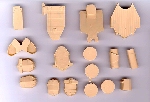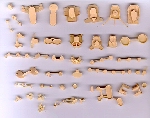Review by Felix Bustelo
The Hiei and her sister ships of the Kongo Class were completed between 1913 and 1915 as conventional battlecruisers with high speeds but limited protection. These ships were designed by Sir George Thurston and the Haruna and Kirishima were the first capital ships to be fully constructed in Japanese naval yards. The Hiei was constructed in Japan but a portion of her components was shipped in from England.
During the inter-war years, these ships underwent two major reconstructions. The first, completed during 1927 and 1930, resulted in the fitting of anti-torpedo bulges, new boilers, increased horizontal protection and improved elevation to the 14-inch guns. However, the additional weight caused a reduction in the maximum speed from 27.5 knots to 25.9 knots. The goal of the second reconstruction, undertaken between 1933 and 1940, was to restore the ships' former high speed. To accomplish this, all of the original machinery was completely removed and replaced with new lightweight turbines and boilers. As a result of this new propulsion plant, horsepower was more than doubled. In addition, the stern was lengthened by 26 feet, the antiaircraft armament was increased and a catapult and three aircraft fitted. The Kongo Class ships were reclassified as "fast battleships" with the ability to achieve speeds exceeding 30 knots.
The Hiei, which had been demilitarized in 1929 under terms of the Washington Treaty, had her "Y" turret and all of her secondary armament removed. She was the last ship of the class to undergo the second reconstruction and as a result benefited from the lessons learned during the work done on her sisters. The Hiei was given new fire control arrangements and a bridge structure layout which served as a model for the Yamato Class. In many ways, the Hiei was the most advanced ship in the class.
Because of their speed, the Kongo Class ships were deployed as part of the carrier and cruiser squadrons. The Hiei was part of the Japanese carrier task force that launched the Pearl Harbor attack and later defeated in the Battle of Midway. After Midway, the Hiei was transferred to Guadalcanal. In November of 1942 the Hiei and other ships in the Japanese squadron engaged United States naval ships. Both sides had major losses and the Hiei suffered over 50 8-inch shell hits and multiple bomb and torpedo hits. Taking on water and listing badly, the Hiei was ordered scuttled.
When I heard that there was a producer of resin 1/500 scale Imperial Japanese Navy kits I was eager to learn more. While Nichimo produces a line of injection-molded kits of IJN kits in this scale, they have neglected many subjects. The KazusaMinato Naval Yard is a small Japanese "cottage" business that is attempting to fill in the voids in Nichimo's catalog. The kit of the Hiei is my first look at one of their models and based on my initial impressions I would say that this kit is a mixed bag.
The kit can be constructed as either a full-hull or a waterline model. The hull comes in three pieces. The bottom section is the optional portion below the waterline. This piece captures the shape of the lower hull, with the torpedo bulges and rounded bow. Small locator holes, which need to be drilled out a little, are present for the twin rudders and the bilge keels are well done. The next level up runs from stem to stern and would the lower section if you decided to build a waterline version. The aft section of this part is the quarterdeck and the planking here is nicely represented. The upper section is the main deck running from the fo'csle to just aft of the "X" turret. Again the planked deck is well done and the level of horizontal detail is good. There are some casting voids in the decks, especially in the corners of the deck hatches, which are smooth surfaces. Occasionally there are some small pinholes in the scribed decks. There are some shallow locator holes at points on the deck to properly place the barbettes, so don't confuse these for blemishes. Since the superstructure elements and barbettes are separate parts, this makes painting easier.
Dry fitting the three hull pieces reveal that filling and sanding will be required to hide the seams in the joints. When stacked up, the model captures the handsome lines of the Kongo Class hull profile. All three parts have pour plugs on the starboard bow that need to be removed and sanded smooth. To accommodate the 14 6-inch casemate guns, you will need to carefully cut into the openings in the upper deck section. If you don't, the 6- inch guns will not fit properly and actually stick out. This may be a difficult process to prevent damage to the deck but it has to be done. This should have been taken into account in the design on this part. While the horizontal details are done well enough, the vertical faces of the hull parts are smooth and have no portholes or other details. The locations of the portholes will have to be determined by the modeler and then drilled out.
The remaining 82 parts included the catapult deck, the many levels of the tall pagoda bridge and other superstructure components, the 14-in turrets and barbettes, the 6-inch casemates, the funnels and smaller items like fire control directors, anchors, rudders, propellers and the propeller shaft supports. The distinctive bridge structure has to be stacked up level buy level like tiers on a wedding cake. Similarly to the hull/deck parts, the horizontal detailing is good but again there are no portholes or most other vertical details. Some of the parts have casting plugs that need to removed and sanded smooth. The searchlight tower is a solid cast resin part with the bracing reproduced well but it looks like a part you would find in an old injection molded kit. I am not sure if the modeler is instructed to somehow hollow this to make it look better but I would substitute this with photoetch or that a scratchbuilt replacement.
What are conspicuously missing from the kit are the boats, aircraft, anti-aircraft guns and searchlights. I am not sure and I will check with the proprietor of the KazusaMinato Naval Yard, but I believe that these parts are sold separately. I would highly recommend that they include these parts in the kit because I feel that the model is not complete without them and this is not common practice with other resin kit producers. Another option is to either raid a Nichimo kit or make home resin cast duplicates of the parts you need from a suitable kit.
This kit does not come with any photoetch parts. The only source at this point for suitable photoetch parts in the Gold Medal Models IJN Battleship set, which has parts specific for Kongo Class ships as well as railings and ladders. The kit also does not have the gun barrels for the 14-inch nor the 6-inch guns. These you will have to fashion from suitable rod and tubing.
The instructions are comprised of two sheets in Japanese but with adequate visuals to help overcome any language barrier that you may encounter. Images of the kits parts are mapped to a numbered key appear on the first page. This serves as a cross-reference to exploded diagrams of the subassemblies on the second page. If there are any painting references or assembly notes I cannot tell as they are in Japanese if they are present. While the assembly instructions are a good basis, I would highly recommend acquiring other reference materials. Warship Pictorial #13, from Classic Warships Publishing, is dedicated to the Kongo Class and provides excellent photographic references and good line drawings. Pacific Front Hobbies carries a line of plans produced by Miyukikai (Myco) and they have plans for the Hiei as she appeared in 1942 in 1/200 and 1/300 scales. I ordered the latter set to help me build this model.
If I had to sum this kit up, I would describe it as a "builders"
model, which is a term I think is used for kits which provide you with
the basics but requires some scratchbuilding and photoetch from other sources
to complete. If you are a fan of Imperial Japanese Navy subjects and are
looking for something new in 1/500 scale then you would consider buying
this kit. The price tag is hefty, with 25,000 Yen converting to about $200
US depending on the exchange rate. For this price, I would have expected
that the omitted items such as the boats, floatplanes and anti-aircraft
guns to be included. This model has the potential to be made into an excellent
model, but it will require looking for alternative sources for or scratchbuilding
the missing parts and it will test your modeling skills. My thanks to KazusaMinato
Naval Yard for providing this review sample.
 |
 |
Click on thumbnail for a full-size picture
